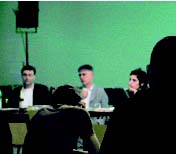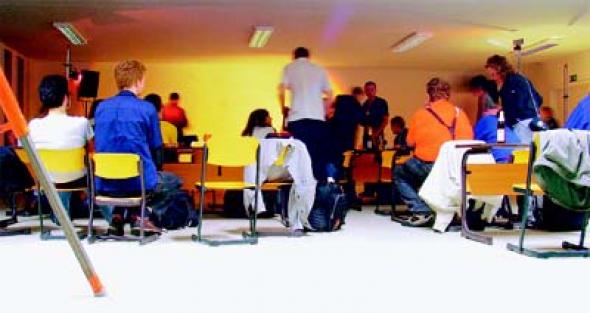Dollarise This!
Natascha Sadr-Haghighian presents meinebank where artists are educating themselves about economics. Includes meinebank's interview with Behrooz Abdolvand and Matthias Adolf on the petrodollar
The relationship between economics and art is thankfully not just a one-way street entailing art’s ever-increasing commodification and imitation of the forms of business. Artists are educating themselves about their assimilation into the knowledge economy and the perfection of creativity’s conversion into value within the bigger picture of economic deterritorialisation. Here, co-organiser of the Berlin-based meinebank project Natascha Sadr Haghighian introduces their work. A transcript of meinebank’s interview with Behrooz Abdolvand and Matthias Adolf about the petrodollar follows
Why is cultural practice so successfully deployed as the role model for the neoliberal workforce? In September the Berlin-based collective meinebank organised Crashcourse, a one month symposium where cultural practitioners gathered in Berlin to discuss their ideas and strategies for dealing with monetary dilemmas. Apart from discussing people’s personal financial situations, different topics were examined including copyright, inner city development, debt, ethnic marketing and the petrodollar. meinebank started off as a collective approach to providing regular exchange and encounters around subcultural concepts. The name – meaning ‘my bank’ – was taken from a local bank’s advertisement. Its main motivation was to look at social economies and their multiple connotations by organising interdisciplinary events with associated groups and individuals. Since April 2000, meinebank has carried out about sixty events that took place in various spaces across Berlin, but mostly in the former GDR’s state bank. The programme’s main intention was to intensify and support associated infrastructures. Its ideal precondition was its own realisation without any cashflow manoeuvres. As the gulf between such a practice and its economic context became more apparent, meinebank decided to leave the no money concept behind and instead examine the ambivalences of money within cultural production. The collective applied for a federal grant and created a scenario in which the cashflow was carefully watched, different models of trading, funding and producing were discussed, conflicts and distortions documented and the question posed: what are the trade values of cultural production? It seems that since the 1970s more than just the concept of labour has shifted towards immateriality. At the transition point between Fordism and post- Fordism, the link between value and its material guarantor was dissolved at its very economic foundation: the abolition of the gold standard. The dominant currency, the dollar, became a fiat currency (a currency that is not backed by any real commodity) and even more powerful as a result. The dollar is still in crisis which obviously not only effects the US but the whole world. To find out more, meinebank invited Behrooz Abdolvand and Matthias Adolf – two scientists whose detailed research into the petrodollar was recently published in a German magazine (‘Verteidigung des Dollar mit anderen Mitteln’, Blaetter fuer Deutsche und Internationale Politik, 2/03). A two-hour talk at the Crashcourse symposium made clear that the US’ recent military adventures have been more about defending their currency than controlling resources.
MB: What precisely are petrodollars?
BA: The oil price does not obey the normal law of value, it is not determined by the most favourable terms of supply. There is not enough low-cost oil production to meet the entire demand, hence the price adapts to more expensively produced oil. The price difference generates extra profit for those countries able to produce more cheaply – the so-called differential rent. These extra profits are called petrodollars.

MB: Since when have petrodollars been in circulation?
BA: Since the 1973 oil crisis. Until World War II, oil was predominantly traded in pounds sterling. Since then, the oil price has been calculated in dollars. But in order to understand the developments of the last fifty years, we have to go back to Bretton Woods.
MB: What was decided in 1944 in Bretton Woods and why did the treaty collapse in 1973.
MA: Bretton Woods organised the post-war economic order. The GATT treaty regulated international trade, the World Bank regulated economic development and the IMF was supposed to prevent economic crises. However, the IMF – officially part of the UN – has no control over the dollar as reserve currency. The latter underlies the structure of the Federal Reserve which is itself an association of private banks. In contrast to the Federal Reserve, the European Central Bank is state controlled. In Bretton Woods the gold price was determined at $35 per ounce. The other currencies were bound to the dollar by more or less fixed exchange rates.
The Bretton Woods structure was eventually undermined by the US’ excessive creation of money. Particularly the wars in Korea and Vietnam led to high overseas debt. In late 1972, debts rose to $78 billion, while there was merely the equivalent of $11 billion in the gold depot. The gold standard could not be sustained anymore.
MB: What happened after the breakdown of Bretton Woods.
BA: The US introduced a new factor into the game: oil and its price. From 1973 onwards, OPEC drove up oil prices and the US tolerated it. This led to an accumulation of dollars in the Arab world. The surplus money was reinvested mainly in the US and Europe, resulting in the emergence of the petrodollar recycling system. The oil price thus became an instrument of financial policy, able to influence the trend in foreign markets.
MB: Does that mean that oil took the place of gold as the basis of the dollar?
BA: Carbohydrates as suppliers of energy in general. Carbohydrates provide the foundation of our civilisation. Controlling them became state doctrine in the US.*
MB: Thus, the war in Iraq was indeed about oil?
MA: Yes and no. The US do not depend on oil imports from Iraq. By now, Canada has tapped much larger oil fields. Besides, the costs of the military intervention are out of proportion to the gain. They amount to twenty times the normal oil price if calculated per barrel gained. However, the US does run into problems if other countries acquire access to the Middle Eastern oil and pay for it in their own currencies. This would undermine the dollar as the reserve currency.
MB: What relation does all this have to the war in Iraq then?
BA: Since the end of 2000, Iraq had been selling its oil for euros and shifted its national reserves to the euro as well. After the war, one of the Federal Reserve’s first measures was to bring billions of dollar bills into the country in order to replace the dinar. A veritable ‘dollarisation’ of the national economy. Furthermore, the occupation of Iraq could help to bring Iran, who deals part of her oil in euros, back to the dollar.
MB: The word is that without stabilisation through the petrodollar the dollar would have to be devalued by 60 percent?
BA: The productivity of the US economy corresponds to 28 percent of world trade while the dollar constitutes 60 percent of the world’s money supply. Consequently, the dollar supply should be reduced. Is the US going to buy the dollars back with gold or foreign currency? Unimaginable. Or will it raise interest rates to regain the capital? Impossible. Currently, the US seems to be willing to sustain her geo-economic position by military means.
The greatest benefit of having a national currency that is simultaneously the world currency results from the so called Seigneurage advantage. The US are in possession of a machine that prints money. The Federal Reserve holds the exclusive right to distribute dollars. Let’s assume that I am sitting here issuing you bonds as someone who works for me. You then go and deposit the bonds as savings in my bank. That is currently reality.
MB: For how long is it possible to sustain such a system?
MA: Contrary to export-economies such as Germany, Japan or China, the US and Britain show a permanent balance deficit. For Britain it amounts to about $30 billion annually, for the US to about $600 billion, i.e. 5 percent of the GDP. One can imagine the amounts accumulated over the last decades. In strictly economic terms the US is bankrupt. A daily supply of $2 billion is necessary to finance the US’ deficit.
MB: Is there a risk of significant geoeconomic conflicts between two ‘currencyblocks’? Was the euro invented for thispurpose?
BA: Initially, there was the ecu – a sort of half-hearted European version of Bretton Woods (with fixed exchange rates and 1 percent floating) for the protection of the internal market. At the 2+4 treaty, France only accepted German reunification on the condition that the deutschmark would be abandoned and the euro accepted. Currently there is a sort of economic balance of power between the euro and the dollar with the Europeans trying to get into the Seigneurage position as well. Either the attempt to revitalise the US economy through regulation supported by countries like Germany, Japan, and China succeeds, or there will be another war in the Middle East. It’s either regulation or war.
MB: Would it be feasible to reorder the state of affairs without a crisis?
BA: I hope so. The problem is solvable only through international co-operation, meaning the successive reorganisation of the world economy within an economic system that links money supply to production.
MA: We are talking about long-term transitions, a ten-year term. Nobody is interested in a destabilisation of the US.
NOTE
* Mute editor: We think 'carbohydrates' here intends 'hydrocarbons': oil, gas, coal are all formed of these naturally-occurring compounds of hydrogen and carbon.
meinebank.crashcourse [ http://www.mnbnk.info ]
Stefan Heidenreich < stefan.heidenreich AT rz.huberlin. de > lives in Berlin, works for the ‘History and Systematics of Digital Media’ project, Cultural Studies Dept., Humboldt-University Berlin and is author of Was Verspricht die Kunst? (The Promise of Art), Berlin, 1998
Natascha Sadr Haghighian is a part of meinebank and lives in Berlin
Mute Books Orders
For Mute Books distribution contact Anagram Books
contact@anagrambooks.com
For online purchases visit anagrambooks.com








